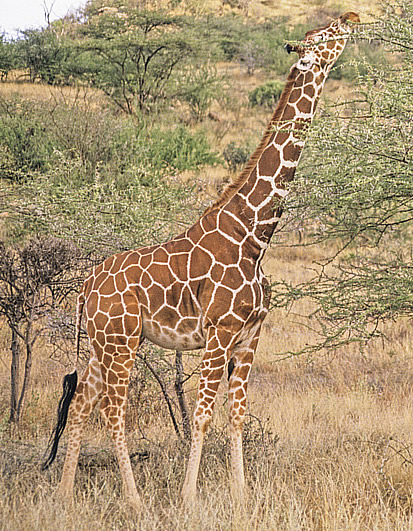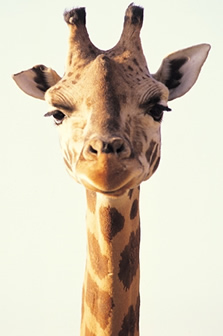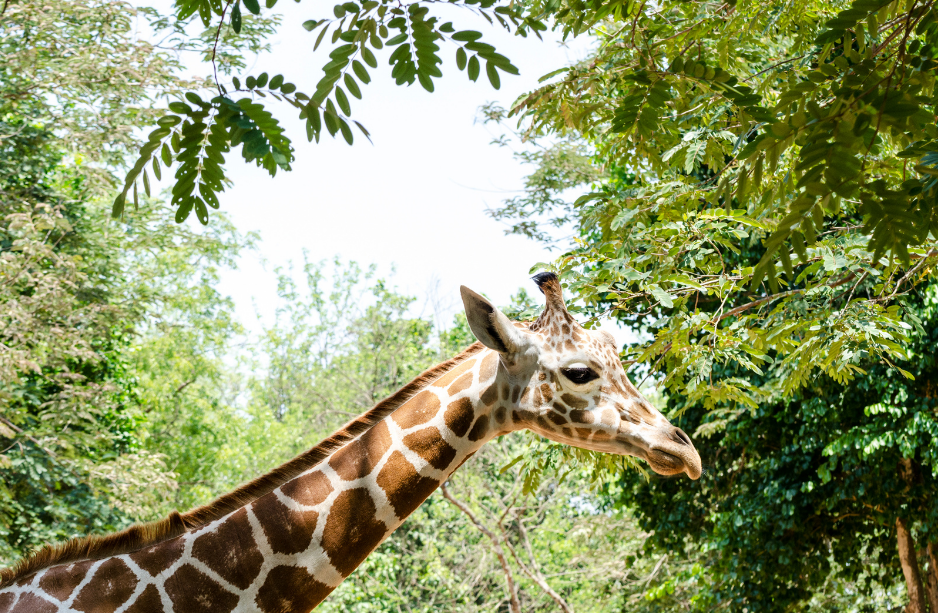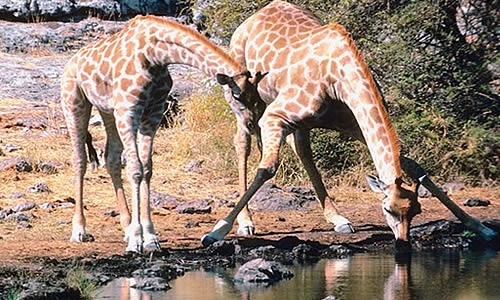The Baby Giraffe Loves to Peek It's Head Over the Top of the Fence and Look Out.
The Giraffe (Giraffa camelopardalis meaning 'fast walking camel leopard) is an African even-toed ungulate mammal, the tallest of all land-living brute species.
The giraffe is related to deer and cattle, yet, information technology is placed in a divide family, the Giraffidae, consisting only of the giraffe and its closest relative, the okapi.
The giraffes range extends from Republic of chad to Due south Africa. Although the Okapi is much shorter than the giraffe, it likewise has a long neck and eats leaves and both animals have long tongues and peel-covered horns.
The giraffes ancestors beginning appeared in central Asia about 15 million years ago, however, the earliest fossil records of the giraffe itself, from State of israel and Africa, date back about 1.5 million years.
Male person giraffes are called 'Bulls', female giraffes are called 'Cows' and baby giraffes are called 'Calves'.
Giraffe Characteristics

The giraffe is the tallest living beast which is instantly recognizable by its exceptionally long neck. Adult males stand 15 – 19 feet (4.6 – 6.0 metres) tall, whereas females are shorter at 13 – xvi feet (4 – 4.8 metres) tall. Adult males weigh between i,764 – iv,255 pounds (800 – 930 kilograms), while females counterbalance only i,213 – 2,601 pounds (550 – ane,180 kilograms).
The giraffe has the longest tail of whatsoever land mammal. Their tail can grow to be eight feet (2.four metres) long, including the tuft on the cease.
In improver to its great height, the giraffe is as well ane of the heaviest land animals. Exceptionally big males may weigh up to 1,900 kilograms (nigh iv,200 pounds).
Female giraffes are smaller, rarely reaching half that weight. Compared to other hoofed mammals the giraffe has a relatively short body, however, its legs are disproportionately long.
A giraffes front legs are about 10% longer than their hind legs, a feature that contributes to the animals steeply sloping back. Mature giraffes accept large hooves about the size of dinner plates, effectually 12 inches wide.
Giraffe Habitat
Giraffes can inhabit savannas, grasslands or open woodlands. Giraffes prefer areas enriched with acacia growth (a genus of shrubs and trees). Nigh giraffes live either in East Africa or in Angola and Zambia in southwestern Africa. Until the center of the 20th century giraffes were also commonly found in West Africa, due south of the Sahara. Merely populations at that place take fallen sharply and get increasingly fragmented.
Giraffe Diet
Giraffes alive in habitats where the available food varies throughout the year. During the dry season, giraffes swallow evergreen leaves, however, once the rainy season begins, they switch to new leaves and stems that sprout on deciduous copse. Besides, twigs and branches are pulled into the mouth of the giraffe with their long and dextrous tongues. In the wild giraffes can eat up to 66 kilograms of food daily.
When there is a choice, male person and female giraffes feed in dissimilar ways. Males concentrate on leaves from the highest branches, while the females curvation their necks to consume closer to the ground. Considering of this feature behaviour, a giraffe can be identified as either male or female from a long altitude away simply past its stance while eating. Male giraffes are also more inclined to wander into dense woodland, a habitat that females more often than not avoid.
Giraffes drink big quantities of water and as a outcome, they tin can spend long periods of time in dry, arid areas. When searching for more food they will venture into areas with denser leaf. The giraffe has tough lips to ensure there is no damage to their mouths when chewing at trees and twigs such as thorns.
Giraffes in captivity are generally fed on alfalfa hay and pellets, apples, carrots, bananas and scan (elm and alder are favourites).
Giraffe Behaviour
Female giraffes associate in groups of a dozen or so members, occasionally including a few younger males. Male person giraffes tend to live in bachelor herds, with older males often leading solitary lives. A individual giraffe can bring together or leave the herd at whatsoever time and for no particular reason.

Considering giraffes are so widely scattered, information technology may seem that they practice not go along in contact with each other, however, this is non true. A giraffes keen eyesight means they can keep an centre on their neighbours even at a distance.
Female giraffes spend just over half a 24 60 minutes mean solar day browsing, male giraffes spend less time doing this – almost 43% of the time that the female does. Dark is mostly spent lying down ruminating, especially in the hours after dark and before dawn.
Male person giraffes spend about 22% of the 24 hours walking, compared to xiii% for female person giraffes. The residuum of the time male giraffes are searching for a female person giraffe to mate with. Giraffe herds practise not have a leader and individual giraffes show no item preferences for others in the herd.
Immature giraffes are never left alone, nevertheless, they are looked subsequently in a kind of nursery grouping where the females help look afterwards each others calves (baby giraffes).
Giraffes spend up to half their fourth dimension feeding and most of the residue is taken up either by searching for food or slowly digesting what they have eaten. Sometimes giraffes slumber during the daytime, frequently while standing.
Giraffes usually prevarication down simply at night, tucking their feet under the body and usually keeping the head upright. However, when a giraffe is sleeping, something it does but for only a few minutes at a fourth dimension, it curves its neck effectually and rests its head on or near its behind.
One of the most fascinating elements of giraffe behaviour is the duel between males fighting for mating partners. Giraffe duels are amid the most extraordinary in the fauna kingdom. Duels brainstorm when two males approach each other and engage in rubbing and intertwining their necks. This behaviour is known as 'necking'. It allows the opponents to appraise each others size and strength.

Oft, necking alone is enough to found authorization. If non, the rivals begin to exchange blows with their heads, using their short horns to tackle each other.
Each giraffe braces its front legs and swings its head upward and over its shoulder. If a blow lands solidly, the giraffe may stagger nether the impact and in rare cases may even collapse onto the ground. More often the contest breaks off after a few minutes and the loser simply walks away.
Giraffe Reproduction
The Giraffe breeding season can occur at whatsoever time during the year. However, births in the wild ordinarily happen during the dry flavor and births in captivity tin happen all year round. Giraffes achieve sexual maturity in captivity at around iii – four years old, nonetheless, in the wild, males do non ordinarily breed until they are 6 – 7 years onetime. In dissimilarity to the male convenance age, females must be physically larger to deport offspring.
When male giraffes are ready to breed, they begin the ritual combat over mates. Giraffes are non- territorial and a successful male giraffe will mate with receptive female giraffes whenever and wherever it finds them.
Gestation period is ordinarily 13 – xv months and when a pregnant female giraffe is ready to requite nativity, she makes her way to a calving surface area that she will use throughout her life. The moment of birth is dramatic, with the mother giraffe standing on all fours and the dogie tumbling onto the ground. Remarkably, the calf is rarely injured by its fall.
Newborn giraffes are often on their anxiety inside twenty minutes and are soon feeding on their mothers milk. Calves tin can walk almost an hour later birth and tin can run within 24 hours of birth. Giraffe calves are nigh 2 metres (six feet) tall at nascency and weigh 104 – 154 pounds. Giraffe calves abound about 3 centimetres tall each twenty-four hour period during the first week and double their height in their first year.

Past the historic period of one year giraffe calves can measure out 10 anxiety alpine. Giraffe calves are weaned at one twelvemonth and get fully independent by 15 months of age. Female giraffe calves are fully grown past age five and male giraffe calves by the age of seven.
Immature giraffes may suckle for upwards to a year, nonetheless, they get-go to sample plants but a few weeks afterward birth. Giraffe calves are ready to go out the protection of their mother later on 15 – 18 months of evolution.
Developed giraffes by and large have no predators other than lions and humans, as their huge hooves are very effective in defending against predators. Giraffes are more vulnerable when they are lying downwards or drinking, because this gives lions the opportunity to spring up and seize them by the nose or throat.
Newly born calves are at much greater gamble. Despite their mothers best efforts to protect them, over 50 percent of all giraffe newborns are killed by hyenas and big cats such as lions and leopards during the first month of their life. In captivity, giraffes take lived over the age of thirty years, however, their maximum life span in the wild is about 25 years.
Giraffe Sounds
Giraffes are normally silent although they can bellow, grunt or snort when alarmed, equally when confronted by lions, and tin can also moo in distress.
Concord your mouse over the giraffe photo and you may be able to hear a giraffe grunt. (ie just)
Calves (young giraffes) squeal and make a mewing telephone call, cows (female giraffes) seeking lost calves will bellow and courtship bulls (male giraffes) may emit a raucous coughing. Giraffes also give alarm snorts, whereby moaning, snoring, hissing and flute similar sounds have been reported. Giraffes also give out a grunting sound that sounds like a pig.
Giraffe Adaptions

Giraffes take amazing adaptions that help them with their lifestyle in the wild. Because giraffes grow to a very tall height, it gives them access to a level of foliage beyond reach of all other large browsing animals all except maybe, the elephant.
Along with their pinnacle, giraffes have an incredible array of adaptations. For case, their skin colouring provides fantabulous camouflage, as it has many unlike patches of variable size and color.
Giraffes skin is very thick, then it provides ample protection and insulation. Also, the giraffe's long eyelids continue out ants and sense thorns on the branches of the trees from which they scan. The valves in veins of the cervix control a huge blitz of blood to the head when leaning over; this prevents unconsciousness.
There is as well a network of capillaries in the brain called the 'wonder-net'. Information technology acts rather like a shock absorber and is another part of the arrangement that prevents unconsciousness. (Also run into 'Giraffe Anatomy' for more facts about the giraffes neck).
A giraffes tongue is over 18 inches (46 centimetres) long, and the roof of the rima oris is grooved to hands strip leaves off branches. Since giraffes are extremely efficient at processing nutrients and liquids from nutrient, they can survive without h2o for long periods of time. Giraffes ruminate 24-hour interval or night, with periods of sleep in between.
Giraffes also rest with their eyes open up, standing or lying for three to five minutes at a time. Throughout the night, a giraffe may deeply sleep for five to 10 minutes lying down, yet they rarely sleep more than xx minutes total per mean solar day.
Giraffe Conservation Status
Similar many of Africas large mammals, giraffes have declined in numbers and in range over the last century. At one fourth dimension, herds of over 100 animals were common in savanna regions across the continent, still, today concentrations like these exist simply in East Africa particularly Tanzania Serengeti National Park.
The decline of giraffe populations has largely been due to hunting. In Africa, the giraffe is a traditional source of hide and hair and also of tough but nutritious meat. Hunting of giraffes has non yet had a catastrophic effect, every bit it has on some of Africas big-game animals, simply it is a crusade for concern. The natural habitat of the giraffe is besides being impacted more and more past human activities, reducing the animals range.
The giraffe is currently a protected species throughout almost of its range and is classed as conservation-dependent by the World Conservation Union (IUCN). The giraffes prospects for survival are good for those living in national parks and game reserves, but for animals living exterior these areas the future is less secure.

Giraffe FAQs
How tall is a giraffe?
The giraffe is the tallest living animate being on state. Fully grown giraffes stand 4.3 to five.vii m (14.1 to 18.seven ft) tall, with males taller than females. Despite its long neck and legs, the giraffe's torso is relatively short.
A giraffe's neck can be up to 2.four m (seven.ix ft) in length. It results from a disproportionate lengthening of the cervical vertebrae, non from the addition of more vertebrae. Each cervical vertebra is over 28 cm (11 in) long. The giraffe'due south elongation of the cervix largely takes place after birth, because giraffe mothers would have a difficult time giving birth to young with the aforementioned cervix proportions every bit adults.
Information technology has been suggested that competitive force per unit area from smaller browsers, like kudu, steenbok and impala, encouraged the elongation of the giraffe'southward neck, as it enabled giraffes to reach food that competitors could not. Giraffes tin feed up to iv.5 k (15 ft) high.
What audio does a giraffe make?
Early biologists suggested giraffes were mute and unable to produce air flow of sufficient velocity to vibrate their vocal folds. However, they have been recorded communicating using snorts, sneezes, coughs, snores, hisses, bursts, moans, grunts, growls and flute-similar sounds. During nighttime, giraffes appear to hum to each other to a higher place the infrasound range.
During courtship, males emit loud coughs. Females also call their young by bellowing. Calves will emit snorts, bleats, mooing and mewing sounds.
How long does a giraffe live?
Giraffes have an unusually long lifespan compared to other ruminants, and can live to up to 38 years. Adult giraffes are non usually preyed on because of their size, eyesight and powerful kicks, however, lions can prey on smaller individuals and giraffes are a common food source for big cats. Developed females are a lot more likely to survive if the group in which they socialize is bigger.
Giraffe calves are much more vulnerable than adults and are also preyed on by leopards, spotted hyenas and wild dogs. A quarter to a half of giraffe calves reach adulthood. Calves born during the dry flavor have higher survival rates.

What practise giraffes eat?
Giraffes are herbivores and are known to eat up to lx different species of plant. They most unremarkably eat from acacia copse just likewise scan for wild apricots, flowers, fruits and buds along with eating seeds and fresh grass but after the rains. When stressed, giraffes may chew the bark off branches.
A giraffe eats around 34 kg (75 lb) of leaf daily. They more often than not consume during the outset and terminal hours of daytime. They get 70% of their moisture from their food so need to drinkable very footling. In fact, they tin survive for up to three weeks without drinking h2o. Still, when they exercise come beyond clean water, they must splay their forepart legs (which are longer than the dorsum) in social club to go their head close enough to the footing to drink.
Giraffe requires less nutrient than many other herbivores because the foliage it eats has more full-bodied nutrients and it has a more efficient digestive system. As a ruminant, giraffes first chew food, and then swallow it for processing and and then visibly passes the half-digested cud upwards the neck and dorsum into the mouth to chew again.
Their height helps them to reach branches and leaves that other animals cannot. Competition for food is thought to be the primary reason why their necks are so long. They employ their prehensile lips and flattened, grooved teeth are able to strip the leaves off the branches.
How do giraffes sleep?
Giraffes usually sleep lying down, although continuing sleeps have been recorded, particularly in older individuals. In captivity, a giraffe sleeps intermittently around four.6 hours per day, by and large at night, just in the wild they can slumber as lilliputian as v to 30 minutes in a 24 hour period. The near common amount of sleep for giraffes is between one and ii hours.
Giraffes also go through intermittent short "deep sleep" phases. These are characterised by the giraffe bending its neck backwards and resting its head on the hip or thigh.
Where exercise giraffes alive?
Giraffes are native to Kenya, Republic of cameroon, Chad, Niger, Uganda, Namibia, Republic of botswana, Zimbabwe, Zambia, Tanzania, Angola, and S Africa. They were originally found in over 20 African nations but are now extinct in 7 nations – Burkina Faso, Eritrea, Republic of guinea, Republic of mali, Mauritania, Nigeria and Senegal. Most giraffes live in E Africa, although some are found in the reserves of Southern Africa. The largest concentration of these animals are found in National Parks.
The different subspecies of giraffe live in different countries in Africa, just certain species have declining populations in areas, mostly due to habitat loss and poaching. The Uganda giraffe historically lived in western Kenya, Uganda, and southern Sudan, simply now survives in but a few pocket-size, isolated populations in Republic of kenya and Uganda. The Nigerian giraffe is at present constitute in just one surface area of Niger. The reticulated giraffe lives in Somalia, southern Ethiopia, and northern Kenya.
Giraffes normally inhabit savannahs and woodlands, where at that place are large amounts of leafage for them to feed on. Their coloring helps them to alloy in with their surroundings, but they are then big that they are safer in numbers instead of trying to hide.
Considering giraffes feed on vegetation that is loftier in the copse only also too woody for the mouths of smaller herbivores, they are too able to remain in areas where domestic grazing has obliterated the found species close to the ground.
What is a group of giraffes called?
A grouping of giraffes is chosen a tower! Giraffes are social animals and are usually found in groups, often called herds. The groups vary in size and limerick, only can range in size from one to upwardly to 66 individuals! Giraffe towers tend to exist sex-segregated, although mixed-sex groups made of adult females and young males also occur.
Females are more selective about who they acquaintance with from the reverse sex, and many herds are made upwards of mothers and their young. As they go older, males become more solitary but may also associate in pairs or with female groups.
How does a giraffe move?
Giraffes have two means of moving, a loping walk and a gallop. When they walk, the giraffes motility both feet on ane side of their body in unison, followed past both feet on the other side. When they run, giraffes motion the front feet together, then the back anxiety, swinging the hind feet up and planting them in front of the forefeet. While running, the neck of a giraffe moves backward and forwards to keep the animal counterbalanced. Giraffes have a meridian speed of nigh 56 kilometres per 60 minutes (35 miles per hour), however, because its legs are so long a galloping giraffe does not appear to be going very fast.
Giraffes are non great travelers, despite their long legs. Giraffes cannot walk over swampy ground because their hooves apace sink and they very rarely wade across rivers. Giraffes on opposite banks of a river may never come into contact, unless the water levels drop.
How does a giraffe curve down?

For giraffes, angle down is a daily challenge. To reach ground level for example, when drinking a giraffe has to splay its front end legs at an angle of near 45 degrees.
A giraffes circulatory organisation is also specially modified, because the high pressure level needed to pump blood up to its caput could cause brain damage when the caput is lowered. To deal with this trouble, giraffes have elastic blood vessels that relieve some of the excess force per unit area.
Giraffes also have a series of valves in their neck veins that ensure that blood e'er flows from the caput dorsum towards the heart, even when this means going against gravity.
When giraffes practise bend down to drink at h2o holes, it is ordinarily done in pairs. This is so that one giraffe tin can drink, whilst the other keeps an heart open for predators.
prevatteaddis1944.blogspot.com
Source: https://animalcorner.org/animals/giraffe/
0 Response to "The Baby Giraffe Loves to Peek It's Head Over the Top of the Fence and Look Out."
Postar um comentário